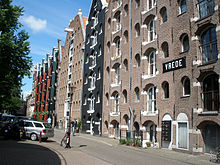Westelijke Eilanden
| province |
|
| local community |
|
| surface | 0.22 |
| Residents | 2,905 (Jan 1, 2019) |
| Coordinates | 52 ° 23 ' N , 4 ° 53' E |
| Important traffic route |
|
| prefix | 020 |
The Westelijke Eilanden ( German West Islands ) are a residential area ( ndl. Buurt ) in the west of the Amsterdam city center and consist of three islands. In 2019 the district had 2,905 inhabitants. The islands are located to the west of Amsterdam Central Station and are bounded by the Zeeheldenbuurt in the north, Haarlemmerbuurt West in the south, Placiusbuurt Noord in the west and the buurt Westerdokseiland in the east.
history
The islands of Bickerseiland , named after the then mayor Johan Bicker , Prinseneiland and Realeneiland , belong to the Westelijke Eilanden , which are located to the west of Westerdokseiland . The name Reaeleneiland comes from the previous owner Reynier Reael.
The first plans to build the islands date back to 1610. Between 1614 and 1615 the islands were created with the names Vooreiland , Middeneiland and Achtereiland . The islands' purpose was primarily for shipyards , herring fisheries and tar-making operations.
Around 1615 Johan Bicker had settled on the Bickerseiland as a shipbuilder and in 1631 he was the owner of the island. Around 1660 there was a wooden church on the island, the Eilandskerk (literally: island church ). It was replaced by a stone church in 1736. It was closed in 1939 and demolished in 1960.
Reynier Jansz Reael (1588–1648) was one of the most important owners of Realeneiland . Against the interests of the city of Amsterdam, he did not have shipyards built but houses. Warehouses ( pakhuizen ) for herring, wine, tobacco, salt, tar and grain were added later .
In 1623, after years of conflict with the city of Amsterdam, the first building plots on the Prinseneiland were sold . Around 1819 there were around 940 warehouses in Amsterdam, 126 of which were on Westelijke Eilanden .
After the 18th century, numerous shipyards and businesses for ship accessories were built. The three islands have been residential areas since 2011 . The former warehouses have been renovated and divided into apartments.
literature
- Jaap-Evert Abrahamse, De grote uitleg van Amsterdam. Stadsontwikkeling in de zeventiende eeuw . Pages 44, 93, 94, 281. Uitgeverij Toth, February 2011. ISBN 978-90-6868-491-9
- Herman Souer, De Westelijke en Oostelijke Eilanden . Uniepers, July 2006. ISBN 978-90-6825-310-8
- Philip Snijder, Sonntagsgeld (novel about a late childhood on Bickerseiland in the 1960s.) . Claassen, November 2008. ISBN 978-35-4600-434-3
Web links
- Photos of Westelijke Eilanden (English)
- Online information about the share committee Westelijke Eilanden In: Het Staatsarchief , International Institute for Social History (IISG, Amsterdam)
Individual evidence
- ↑ Gebiedsindelingen Gemeente Amsterdam, accessed on May 13, 2020 (Dutch).
- ↑ Art Amsterdam islands history of Westelijke Eilanden , accessed on 19 January 2013 (Dutch)
- ↑ https://allecijfers.nl/buurt/westelijke-eilanden-amsterdam/ Maatwerk informatie service, accessed on May 13, 2020 (Dutch).
- ↑ See on this: JE Abrahamse, De grote uitleg van Amsterdam . Page 44
- ↑ See: JE Abrahamse, JE, De grote uitleg van Amsterdam . Page 93–94
- ↑ See on this: JE Abrahamse, De grote uitleg van Amsterdam . Page 281
- ↑ Information about the warehouses . History of the Westelijke Eilanden . With photos. Dutch, accessed June 15, 2011
- ^ History of the Westerdok . With information about the Westelijke Eilanden . Dutch, accessed June 15, 2011

